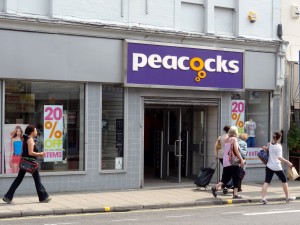 Fuel prices at German petrol stations fluctuate wildly – by up to €0.14 per day. They are also often changed several times per day. In morning rush hours, when demand is less elastic, prices may shoot up, only to drop again once people are at work.
Fuel prices at German petrol stations fluctuate wildly – by up to €0.14 per day. They are also often changed several times per day. In morning rush hours, when demand is less elastic, prices may shoot up, only to drop again once people are at work.
But is this a sign of healthy competition? Critics claim the opposite: that it’s a sign of the oligopoly power of the oil companies. More than two-thirds of Germany’s petrol stations are franchises of five big oil companies: BP/Aral, Esso, Jet, Shell and Total. These five companies directly control the prices at the pumps. According to the Der Spiegel article below, oil companies:
have sophisticated computer systems that allow them to precisely control, right down to the minute, when they increase their prices nationwide, and by how many cents. The prices are not set by the individual franchise holders. Instead, they are centrally controlled – for example, in the town of Bochum, at the headquarters of Aral, a BP subsidiary that is the market leader in Germany.
The price manager merely presses a button and price signs immediately change at all 2,391 Aral service stations in Germany. All filling stations are electronically linked with Bochum via a dedicated network called Rosi. After each price increase, they watch closely to see how the competition reacts and whether they follow suit.
… If the competitor’s prices are significantly cheaper, the Aral franchise holder can, with the help of Rosi, apply for permission to reduce the prices again.
Not only do the oil companies control the prices at the pumps, but they observe closely, via their franchise holders, the actions of their rivals, and then respond in ways which critics claim is collusive rather than competitive. The problem has become worse with the introduction of incentives to the franchise owners of additional commission if they exceed the price of their competitors within the local area. This has the effect of ratcheting prices up.
The sophisticated pricing strategies, with prices adjusted frequently according to price elasticity of demand, are making it very hard for independent operators to compete.
In response, the German Cartel Office has launched an investigation into the oil companies and in particular into the issues of collusion and frequent price changes and how these impact on independent operators.
German anti-trust authority probes alleged fuel cartel Deutsche Welle (4/4/12)
German antitrust watchdog to probe oil majors-paper Reuters, Ludwig Burger (3/4/12)
Oil giants probed over claims they rigged petrol prices in Germany The Telegraph, Nathalie Thomas (4/4/12)
BP, Exxon, Esso, Jet, Shell and Total in Germany Price Fix Probe International Business Times (9/4/12)
German cartel office probes petrol company pricing MarketWatch (4/4/12)
Kartellverfahren gegen fünf Mineralölkonzerne (in German) Frankfurter Allgemeine Zeitung, Helmut Bünder and Manfred Schäfers (4/4/12)
Crazy gas prices driving German consumers mad msnbc, Andy Eckardt (3/4/12)
Big Oil’s Strategy for Jacking Up Gas Prices Der Spiegel, Alexander Jung and Alexander Neubacher (5/4/12)
Questions
- What the features of the German road fuel oligopoly?
- Why does the price elasticity of demand for petrol and diesel vary with the time of day? Is it likely to vary from one week to another and, if so, why?
- In what ways have the actions of the big five oil companies been against the interests of the independent petrol station operators?
- Consider the alternatives open to the German Federal Cartel Office for making the market more competitive.
- Would it be a good idea for the big five German companies to be forced to adopt the Western Australian system of price changes?
 It’s not the first retailer to go into administration and it won’t be the last, but the well-known high street retailer Peacocks will continue to trade for the foreseeable future thanks to Edinburgh Woolen Mill.
It’s not the first retailer to go into administration and it won’t be the last, but the well-known high street retailer Peacocks will continue to trade for the foreseeable future thanks to Edinburgh Woolen Mill.
The administrators were called in at the beginning of 2012, as Peacocks total debt reach £750 million and it was unable to restructure £240 million of this debt. Edinburgh Woollen Mill has bought the company out of administration, protecting 6000 jobs in the UK. However, at the same time more than 3000 workers will be made redundant, as 224 stores cease trading.
Throughout the recession, retailers across the UK have been struggling, as household incomes have remained low, causing consumer spending to fall. One of the administrators from KMPG, commented that:
‘This (the low consumer demand), combined with a surplus of stores and unsustainable capital structure, led to the business becoming financially unviable.’
 The coming months will be crucial in determining whether more jobs are lost and if there are any further store closures. Much hinges on the ability of Edinburgh Woollen Mill to stabilize the financial performance of Peacocks and stimulate renewed customer demand. The following articles consider this take-over.
The coming months will be crucial in determining whether more jobs are lost and if there are any further store closures. Much hinges on the ability of Edinburgh Woollen Mill to stabilize the financial performance of Peacocks and stimulate renewed customer demand. The following articles consider this take-over.
Peacocks closes 19 Ulster stores with 263 job losses Belfast Telegraph (23/2/12)
Peacocks Takeover: Edinburgh Woollen Mill buy retailer but 3,100 jobs lost BBC News (including video) (22/2/12)
Peacocks piqued by PIKs Guardian, Nils Pratley (22/2/12)
Edinburgh Woollen Mill buys Peacocks Independent, James Thompson (23/2/12)
Peacocks sold to Edinburgh Woollen Mill – KPMG The Wall Street Journal, Jessica Hodgson (23/2/12)
Questions
- Why has consumer demand in the retails sector fallen during the recession?
- What type of take-over would you classify this as?
- Who are Peacocks’ main competitors? In which market structure would you place the retail sector? Explain your answer.
- The Guardian article refers to the Management-buy-out of Peacocks in 2005. What is a management-buy-out? What were the problems associated with it?
- What are the problems that have been identified as causing Peacocks to go into administration?
- To what extent do you think the Management-buy-out of 2005 is the main reason why Peacocks has fallen into administration?
 Last year, we felt the cost of the cold weather and whilst we haven’t seen such low temperatures this year, gas shortages are also emerging. Across Eastern Europe, temperatures have fallen well below -30ºC and so demand for gas has unsurprisingly increased.
Last year, we felt the cost of the cold weather and whilst we haven’t seen such low temperatures this year, gas shortages are also emerging. Across Eastern Europe, temperatures have fallen well below -30ºC and so demand for gas has unsurprisingly increased.
Thanks to these low temperatures, Russian gas supplies are running low and several countries have seen their deliveries of gas fall. However, the Russian gas monopoly, Gazprom has said that supplies have not been cut and that it has been exporting more gas during these cold times. The blame, according to Alexander Medvedev (the Deputy CEO of Gazprom), lies with the Ukraine taking gas at a pace significantly above contracted levels. The following articles consider this issue.
Russia, Ukraine argue over gas as EU reports shortage Reuters (2/2/12)
Freezing Europe hit by Russian gas shortage BBC News (4/2/12)
Gazprom says ‘Perplexed’ by EU supply drop as Ukraine takes gas Bloomberg BusinessWeek, Anna Shiryaevskaya (3/2/12)
Gazprom cuts gas supplies amid cold snap Financial Times, Guy Chazan (3/2/12)
Gazprom ‘unable to pump extra gas to Europe’ Associated Press (4/2/12)
Questions
- Using a demand and supply diagram, illustrate what we would expect to see with a gas shortage.
- What has been the cause of this current gas shortage? Use a diagram to illustrate the causes.
- What would you expect to happen to prices following this gas shortage?
- Gazprom is said to be a monopoly: what are the characteristics of a monopoly?
- As there are other gas suppliers, how can Gazprom be said to be a monopolist?
 Is Google’s Android catching up with Apple’s iOS in the market for apps? With Android tablets and smartphones taking an ever larger proportion of the market, you would expect so. In the third quarter of 2011, 53% of smartphone shipments used Google’s Android system, compared with only 15% with iOS.
Is Google’s Android catching up with Apple’s iOS in the market for apps? With Android tablets and smartphones taking an ever larger proportion of the market, you would expect so. In the third quarter of 2011, 53% of smartphone shipments used Google’s Android system, compared with only 15% with iOS.
However, Apple is still ahead of Google in the share of apps downloads. To date, there have been 18 billion downloads from the iOS App Store for iPhone, iPad and iPod Touchs compared with 10 billion downloads of Android apps. But Android downloads are growing faster and are set to overtake those of iOS apps in the coming months. This should be boosted with the new Ice Cream Sandwich Android operating system.
But what about revenues earned from downloads? Here the picture is very different. Android Marketplace has earned around $330 million gross revenue for paid apps. Apple’s App Store, by contrast, has earned over 15 times as much: nearly $5000 million. The reason is that 99% of Android apps are free; the figure for App Store apps is 86%. But why is this so and how can Android earn revenues from its apps? And how can app developers earn revenues from the Android market? The following articles look at the economics of apps.
Android Vs. iPhone: The Economics Of Apps Financial Edge, Manish Sahajwani (6/1/12)
Google has an Amazon problem MSN Money, Jim J. Jubak (25/1/12)
Android and the economics of apps BBC News, Rory Cellan-Jones (7/12/11)
Apple Getting Best Of The Android Vs. iPhone Economics Forbes, Manish Sahajwani (6/1/12)
Fragmentation Is Not The End of Android cek.log, Charlie Kindel (14/1/12)
Questions
- Why are most Android apps free to download?
- What is the business model for (a) developing and (b) offering Android apps?
- How can money be made from free apps?
- What are the long-term strengths and weaknesses in Apple’s apps business model?
- Assess Amazon’s business model for apps for Kindle users.
 Every firm has been hit by the recession and for most, it’s been bad news. However, the latest firm to file for bankruptcy is an interesting case, as the causes extend well beyond a weak economy. The company in question? Eastman Kodak. Renowned for inventing the hand-held camera and being the market leader, selling 90% of photographic film and 85% of all cameras in the USA in 1976, the company has since seen a large change in its fortunes.
Every firm has been hit by the recession and for most, it’s been bad news. However, the latest firm to file for bankruptcy is an interesting case, as the causes extend well beyond a weak economy. The company in question? Eastman Kodak. Renowned for inventing the hand-held camera and being the market leader, selling 90% of photographic film and 85% of all cameras in the USA in 1976, the company has since seen a large change in its fortunes.
Massive competition has emerged from all over the globe and the company has seemed to lag behind the digital revolution. Arguably, unwilling to take risks and making some strategic errors, Kodak saw its stock tumble from $94 in 1997 to under $1 per share in 2012. Since 2004, Kodak has only seen one profitable year. With massive competitors in the world of digital photography, the market has become a highly competitive one. As Rupert Goodwins, the editor of technology website ZDNet said:Kodak made all its money from selling film, then the digital camera came along and now no-one’s buying film. It’s not like they didn’t see it coming. Kodak hesitated because they didn’t want to eviscerate their business.
By filing for bankruptcy, Kodak is protected and its operations will continue for the time being, perhaps giving the company time to have a rethink and a reorganization. Eastman Kodak has previously tried to take a new direction and has been moving away from film and towards its printer, software and packing businesses. The problem is that these markets already have some very strong competitors: Hewlett Packard, Canon and Epson. It’s a difficult job to break into this market and gain market share.
The future of the company is very much in the balance and as reorganization of its operations looks inevitable, so does a loss of jobs. Thank goodness it only employs some 19,000 workers and not the 145,000 it did back in its day. Bankruptcy will certainly keep the creditors at bay for the time being, but it is by no means a long term solution to the company’s ailing profits. The following articles consider this ‘Kodak moment’.
Eastman Kodak files for bankruptcy protection BBC News (19/1/12)
Eastman Kodak files for bankruptcy The Christian Science Monitor, Ben Dobbin (19/1/12)
Kodak: From Brownie and roll film to digital disaster BBC News, James Cowling (19/1/12)
Kodak files for bankruptcy CNN Money, Aaron Smith and Hibah Yousuf (19/1/12)
Photography pioneer Kodak files for bankruptcy Reuters, Jonathan Stempel (19/1/12)
Kodak: 30 fascinating facts The Telegraph, Matthew Sparkes (19/1/12)
Kodak: why the moment has oassed Guardian, Simon Waldman (19/1/12)
Questions
- Using the product life cycle, explain where Kodak currently lies.
- To what extent are Kodak’s current problems related to the obsolescence of their products and not the recession?
- What strategic errors have Kodak made?
- What has caused Kodak’s collapse in share prices and profitability?
- Why is Eastman Kodak finding it difficult to gain market share in other markets, such as printing?
- What options are open to Kodak for the future if it is to become profitable once more?
 Fuel prices at German petrol stations fluctuate wildly – by up to €0.14 per day. They are also often changed several times per day. In morning rush hours, when demand is less elastic, prices may shoot up, only to drop again once people are at work.
Fuel prices at German petrol stations fluctuate wildly – by up to €0.14 per day. They are also often changed several times per day. In morning rush hours, when demand is less elastic, prices may shoot up, only to drop again once people are at work.



